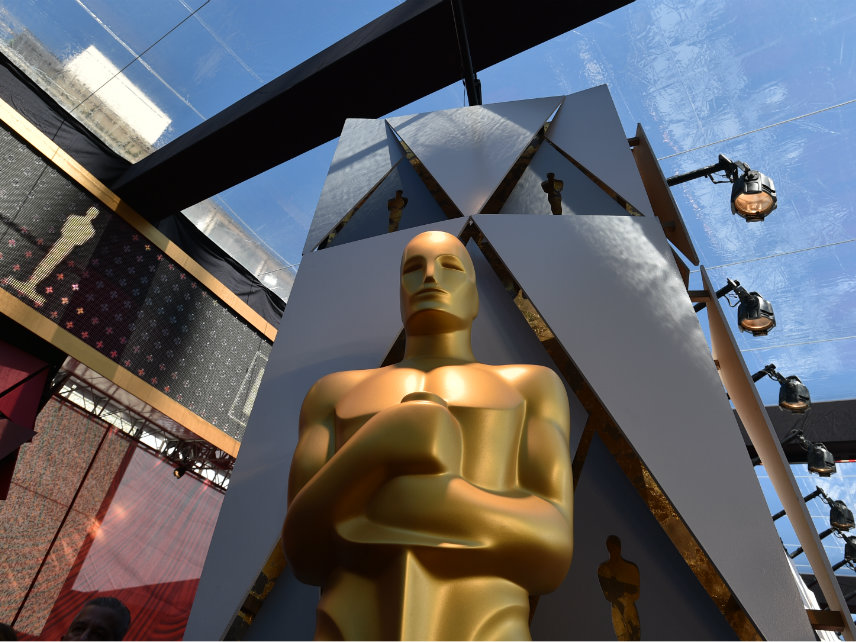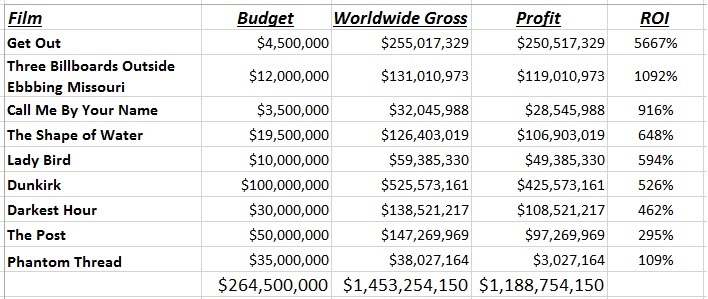In the Market, Get Out and Dunkirk Won the Race for Best Picture
Get Out grossed more than 56 times its budget. Dunkirk earned the most, by far, of any 2018 Best Picture nominee.

Taking home the top prize at Sunday's Academy Awards ceremony requires winning the favor of an exclusive group of movie-making professionals. Even after a deliberate effort to extend Oscar voting rights to a larger number of people, the Academy of Motion Picture Acts and Sciences has a mere 6,700 members.
But this year's Best Picture nominees were seen by millions of people around the world, each of whom voted with their wallets whenever they went to the theater during the past year. In all, this year's nine nominees grossed over $1.4 billion at the worldwide box office, returning a profit of nearly $1.2 billion (which seems like a really good reason to stop subsidizing movies with tax dollars, by the way!).
The spoils were not divided evenly. Christopher Nolan's time-warping World War II film Dunkirk was easily the top-grossing movie among the Best Picture nominees, earning more than $525 million internationally—that's more than one-third of all the money earned by the nine nominees in the category. Dunkirk, though, was also by far the most expensive movie to earn a Best Picture nod, with a budget that was twice as high as the next most costly film: Steven Spielberg's The Post.
In the marketplace, Jordan Peele's woke horror flick Get Out is the clear winner. Despite costing just $4.5 million, Get Out has grossed more than $255 million for an incredible return on investment that's better than 5,600 percent.

This year's Best Picture nominees are the lowest-earning since the 2011 batch, according to Variety. With the exception of Dunkirk (and maybe Get Out), there's not a single film on the list that can rightfully be called a blockbuster. But budgets were relatively low across the board as well, and most of the nominees will end up returning at least five times what they cost to make.
In a year when the race for Best Picture seems closer than usual, the process used to pick the winner might be a factor. Unlike all the other awards handed out at the Oscars, winning Best Picture requires more than a simple plurality of the votes cast. The Academy uses a preferential voting system—the Los Angeles Times has a good explainer of how it works—that can benefit movies for being "least disliked" instead of being the top choice of the widest number of voters.
That's not a bad way to run an election—indeed, it's similar to the ranked choice voting system that some states have experimented with as a way to limit the power of the two dominant parties—but no democratic system is going to be as robust oras responsive to the will of the people as the collective decision-making power of consumers.
The Oscars reward the art of filmmaking, of course, not merely the ability to put people in seats. And obviously, simply paying to see a movie isn't the same as liking it, let alone wanting to give it an award. But tonight's prizes, and the motion picture industry itself, wouldn't exist if people didn't want to spend their money on movies. And when it comes to the marketplace, this year's Best Picture frontrunners are pretty clear.


Show Comments (113)